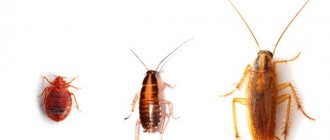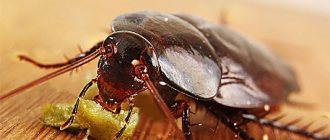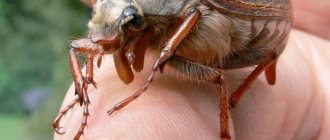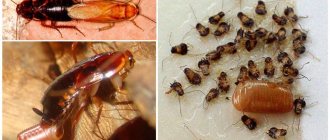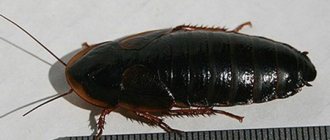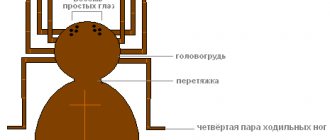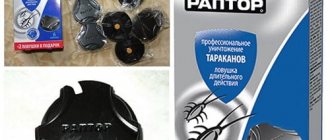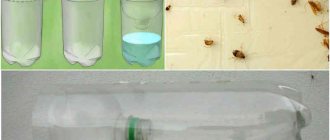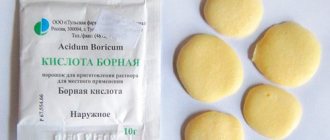Description and appearance
Red cockroaches are insects with an elongated, slightly flattened oval body. This shape provides insects with the opportunity to penetrate even the narrowest crevices. Females have a larger and wider body than males. The body size of an adult European cockroach is from 9 to 16 mm; the largest red cockroaches grow up to 20 mm. The body is covered with a rather soft chitinous cover. Color can vary from light brown to red. A characteristic feature is darker brown stripes on the back.
Prusak
The life cycle of a cockroach includes three stages:
- egg;
- larva (nymph);
- adult (imago).
The reproduction of cockroaches does not depend on the time of year, so in each population there are nymphs at different stages of development and pregnant females. The average lifespan of Prussians is 8–9 months, but how long a particular cockroach will live largely depends on conditions (in particular, the availability of sufficient food and water, and ambient temperature).
Features of the structure of cockroaches
Each of the main parts of the body contains organs that provide vital functions for insects.
What kind of eyes does a cockroach have?
The main organ of vision in cockroaches is compound or compound eyes. They are located on the sides of the head. They have different sizes (large in winged forms) and are kidney-shaped. The interocular space is well defined. Additional organs of vision, simple eyes, help assess the intensity of light. They are small and located at the top of the head. How many eyes does a cockroach have? Insects have 2 main eyes and 2 simple ocelli, which have atrophied in some species.
You will learn about the phenomenal endurance of insects in the article “Without food, water and a head: how long do cockroaches live?”
Type of cockroach mouthparts
Insects that eat solid food have developed gnawing type mouthparts. It consists of several parts:
- Upper lip - sensitive hairs on its surface help in studying food.
- The upper jaw (mandibles) consists of a durable chitinous plate with teeth. Used for biting and grinding food.
- The lower jaw (maxilla) is a movable organ consisting of several segments that supports food during grinding.
- The lower lip helps push food into the pharynx; its palp is an organ of touch.
The cockroach's mouthparts have remained unchanged throughout the entire period of its existence. It allows you to absorb plant residues and any organic matter.
Cockroach limbs
Running is the main method of movement for representatives of the cockroach order. The structure of their legs helps them with this. The limbs consist of 5 parts. They are attached to the body with the help of a coxa, which has developed muscles. The longest segments are the thigh and tibia. The flexible foot consists of 5 segments. There are spines on the legs and thighs. How many legs does a cockroach have? Insects have 2 pairs of limbs, each of which is attached to a specific part of the chest.
Information. Some species have a suction cup on the foot, allowing insects to move along vertical surfaces.
Limbs are used for more than just running and jumping. With them, the imago cleans the antennae and body of food debris. The legs are flexible and mobile, they allow you to quickly change the trajectory of movement in case of danger. The average speed of a Prussian is 3-4 km/h.
The structure of the wings of a cockroach
The ancestors of insects had developed wings and the ability to fly. Many modern species have lost it. Appendages appear only in adults. They consist of two pairs. The first is the leathery elytra. They perform a protective function and do not participate in flight. The second pair are membranous wings. The length and development of the appendages depends on the species. In females, the wings are less developed. In a calm state, insects fold them on their backs.
Flying cockroaches are most often found in the tropics, but some species are found in Central Asia and Europe. Among domestic insects, the American cockroach demonstrates the ability to fly. Although Prussians have long wings, they rarely spread them and can glide.
Internal structure of a cockroach
The vital activity of insects is provided by the main systems:
- circulatory;
- nervous;
- digestive;
- excretory
To understand how insects can live for months without food and about a week without a head, we need to study them in more detail.
Circulatory system - blood (hemolymph) flows in the space between the internal organs of the insect. There is only one vessel in the body connected to the heart. Main muscle. The pumping blood consists of 13 chambers, 2 of them are in the chest, the rest in the abdomen. The function of blood is to transport nutrients and remove waste products. The respiratory system distributes oxygen. This is the main reason for the reduction of blood vessels. The blood movement is slow, the insect does not maintain a constant body temperature.
Information. If you deprive a cockroach of its head, the hemolymph quickly sinteres and the body does not bleed.
When depicted schematically, the respiratory system resembles a tree. It consists of a tracheal system that encircles all important organs. Branches extend from the main trachea, gradually decreasing in diameter. The system is connected to the external environment using 10 stigmas, which are called spiracles in cockroaches. Two pairs of stigmas are located on the sides of the chest, the main part is located on the abdomen. Breathing occurs when the department contracts.
The digestive system is an intestine divided into several sections. In the mouth, food is ground and moistened with saliva. Next, it is pushed into the pharynx, then into the crop, where digestion and absorption begin. Food is fed into the stomach in small portions. It is prepared and sent to the midgut. In this section, the digestive secretion is secreted and the main absorption occurs. Excrement comes out through the anus.
The excretory system or Malpighian vessels remove waste products from the body through the hindgut.
What is the body of a cockroach covered with?
The typical cover of arthropods is a chitinous shell. For cockroaches, this is a shell that protects internal organs. It allows the body to maintain its shape and serves as a skeleton. The outer cover prevents the rapid evaporation of moisture. At the base of the limbs, the layer of chitin is thinner to provide mobility to the legs. The hard shell limits the growth of insects. During development, the larvae have to shed it. The tight shell cracks and the insect crawls out of it. At first his body is white and soft. This is a sign of the absence of chitin. After a few hours the cover is restored.
Information. An encounter with molted arthropods gave rise to myths about white cockroaches.
Body structure
From an evolutionary point of view, the body structure of cockroaches can be called perfect for its lifestyle. This is confirmed by the fact that over millions of years, cockroaches have remained virtually unchanged. The insect's body consists of a rather large triangular head with a pair of compound eyes, a gnawing mouthpart covered by a shield, and long mustache, chest and abdomen. Despite the fact that cockroaches do not fly, they have wings that are hidden under dense elytra.
Three pairs of legs differ in length and main functions. So the first pair (the shortest) is a kind of brake. The second is responsible for maneuverability, since the paws can move in different directions. The third pair is longer than the others and plays a major role in moving and jumping.
Cockroaches have an open circulatory system, that is, blood circulates freely throughout the body, washing the internal organs. The respiratory system is separate. Air enters through holes located on the sides of the abdomen and disperses through the tracheal system. The digestive system consists of the crop, stomach and intestines. In the body cavity of the red cockroach there are Malpighian tubes, which are excretory organs. They collect toxins from throughout the body, which are then eliminated.
Interestingly, red cockroaches do not have an excretory organ such as the urethra, so both urine and feces are excreted through the anus.
External structure of a cockroach
Despite the huge number of species, all insects of the cockroach order have a similar structure. The main differences are usually the size and color of the insect, but the internal anatomy is almost the same between black and red cockroaches.
Nature has given these creatures excellent help in order to crawl into the crack under the densest plinth - an elongated and flat body. It is divided into the abdomen, thorax (which consists of prothorax, mesothorax and metathorax) and head. In addition, each insect has a pair of wings. Did you know that cockroaches can fly? Below I will tell you how the wings of this creature are structured, what importance the wings have for the reproduction of offspring, and why only males can fly.
Head
I propose to start studying cockroach anatomy from the head, which in most individuals is quite large and has the shape of an oval or rounded triangle. From above it is covered by a shield-shaped anterior segment of the chest, from under which only the back of the head is visible, and the rest of the head is turned downwards.
Eyes
On the sides of the head there are paired compound eyes, and on top there are two simple ocelli, which are poorly developed in most species. By the way, thanks to the structural features of their eyes, cockroaches see the world around them as a mosaic assembled from thousands of small multi-colored pieces. And although such vision does not allow one to distinguish the details of an object, the so-called perception of light flickers in a cockroach is 5 times higher than that of a human.
This is why it is so difficult to overtake an insect with a slipper or newspaper - even the fastest person for cockroaches is like a fly stuck in jam. In short, if you've ever asked yourself why these creatures almost always manage to escape punishment, now you know the answer.
Mustache
In children's horror stories, the cockroach is always depicted as a mustachioed monster, and it is not for nothing that so much attention is given to the mustache. It is the antennae that are the organ of thermal sensitivity, touch and smell. They are also used as a means of communication between individuals: by touching their whiskers, cockroaches exchange information. The whiskers are of considerable length and covered with bristles, the number of which increases with each moult and reaches 80 by the age of maturity.
Mouth
Despite their small size, the bites of the red and black cockroach can be noticeable and even painful. The fact is that the oral apparatus of these creatures is of the gnawing type and has a rather complex structure, and each part of it has its own special purpose:
- labrum, or upper lip - articulated with the head in a movable manner, covered from the inside with receptors that analyze the composition of food;
- mandibles, or lower jaw - curved, fairly massive plates, covered with sharp teeth, their purpose is to hold a piece of food;
- maxillae, or upper jaws - located above the lower jaws, necessary for grinding food and chewing;
- labium, or lower lip - surrounds the oral apparatus from below, prevents food from falling.
Read on the topic: Where do cockroaches come from in an apartment and how to get rid of them
On the outside of the lower lip there are special receptors (tactile and taste), which are necessary for searching, detecting and analyzing food.
In addition to the complex jaw, the insect’s mouth contains a salivary gland and a tongue-like organ that helps absorb liquid. As you can see, the mouthparts of a cockroach are an ideal tool for searching for and destroying bread crumbs even in the cleanest kitchen. It is not for nothing that this type of insect is considered the most tenacious.
Breast
On the chest of cockroaches there are wings, elytra and three pairs of legs. The chest consists of three segments, the largest of which is the first - the so-called pronotum. On the sides of this convex hexagonal segment there are depressions where the elytra are placed. Most often, the pronotum has a lighter color compared to the rest of the body, and in some species this part is even transparent.
Legs
As for the insect’s legs, they are located on different segments of the thorax, consist of five parts and are called “pentamerous.” On the four upper segments of the legs there are pads, and on the lower one there are claws, between which there is also a suction cup.
This structure of the paws helps the insect to easily move on any surface - both horizontal and vertical. Moreover, on the paws of this creature there are tiny hairs that catch even the slightest vibrations in the air, thanks to which the cockroach reacts with lightning speed to a moving object.
Strong legs allow it to develop high speed for such a small size - a cockroach can run at a speed of 3-4 km/h. If this figure is not surprising, imagine this: if a cockroach were the size of a cheetah, it could easily catch up with a member of the cat family.
In addition, the peculiarity of the legs determines the high maneuverability of the insect: cockroaches are able to change their movement pattern with lightning speed. Depending on their location, each pair of legs has its own special purpose:
- the prothoracic legs are shorter than all the others, they serve as a kind of brake at high speed of the cockroach;
- the mid-thoracic legs are responsible for high maneuverability, as they are able to move in different directions;
- The metathoracic tarsi are longer than the other two pairs, move the cockroach’s body forward and are the main walking limbs.
Wings
Two pairs of wings are attached to the cockroach's chest. On top there are hard elytra, designed to cover the abdomen and thinner wings. Interestingly, the length of the male's wings is significantly greater than the length of the female's wings. Cockroaches use their wings to accelerate while moving and also to slow down their fall.
Reading on the topic: White cockroaches or a terrible mutant
Fortunately, only one species of cockroaches can fly, but for all the others, their wings are useful for mating games. This is why the male’s wings are longer: during mating, the spread wings form a convenient platform for the larger female.
Abdomen
The abdomen of a cockroach has 11 so-called tergites (segments), but only 8-9 can be distinguished. The tenth segment forms a plate that covers the anus. In females, the abdomen continues with the ootheca - eggs (about 12-16) are stored in this segment. This part of the body has the shape of an oval, and due to its impressive size it is always noticeable and is an obvious difference between a female and a male. It is noteworthy that with sufficient nutrition, the female is capable of producing ootheca every two to three days.
Peculiarities of existence and why is it difficult to get rid of the Prussian?
If there are Prussian cockroaches in your apartment, you must immediately start fighting them. To do this, you will have to make an effort, since getting rid of the mustachioed occupiers will not be easy. This is explained by some features of red cockroaches and their way of life:
- cockroaches are practically omnivorous; they can feed not only on food waste, but also on soap, paper, and dead insects;
- Prussians are nocturnal, active in the dark, and in addition, they are masters of camouflage and move very quickly;
- Domestic red cockroaches are quite prolific, from 20 to 50 eggs develop in one ooteca; in addition, females are very caring mothers, which has a positive effect on the survival of the offspring.
With ootheca
Another difficulty in fighting Prussians is that they quickly adapt to poisons. A poisoned cockroach can be cured by drinking water, and the next time the same poison will not have any effect on it.
Reproduction
Cockroaches are dioecious individuals with noticeable sexual dimorphism. The latter is manifested in morphological differences between males and females. Anyone can identify them. The male is smaller. Its wings are better developed, which allows it to fly short distances. The last segment on the male's abdomen has specialized outgrowths called styli.
The structure of cockroaches determines their ability to internally fertilize. After mating, the female lays eggs covered with a protective membrane called edema. Cockroaches are characterized by incomplete transformation. This means that the eggs hatch into larvae that look like adult insects. It is called imago. At first the larva is deprived of wings. It grows, molts and develops into an adult insect. This period lasts about four weeks. Individuals become sexually mature only after three months.
Cockroaches are very prolific. Over the course of her life, one female gives birth to more than a hundred individuals. She lays eggs repeatedly. And for this she does not have to constantly mate. The fact is that sperm can be stored in the female genital ducts for a long time.
Reasons for appearance
Prussian cockroaches most often settle where the most comfortable conditions are created for them, namely:
- there is water and food;
- warm;
- there are many secluded places where you can hide.
Thus, the main reason for the appearance of cockroaches is an unsanitary environment in the house. Garbage, leftover food and crumbs, leaking taps and pipes, peeling wallpaper, cracks in the floor or walls are factors that increase the likelihood of a cockroach infestation.
Another option is that Prussians can move into an apartment to escape danger, for example, if pest control was carried out somewhere nearby. They also gradually spread out in search of new housing if the population grows, when there is no longer enough food for everyone, and appear from a neighboring apartment, basement or entrance.
Habitats
To feel safe, Prussians need warmth, darkness, and access to water and food. Based on these needs, they choose their places to live. In an apartment, red cockroaches most often settle in the kitchen and bathroom, giving preference to the following places:
- under the sink;
- under and behind the refrigerator (sometimes insects can be found in the rubber seal in the refrigerator door);
- inside a microwave or oven;
- the space between the wall and shelves, cabinets;
- behind skirting boards and ceiling moldings;
- behind peeling wallpaper and peeling wall panels;
- under the bath;
- in ventilation openings;
- inside built-in kitchen furniture;
- in cracks in the floor or walls;
- in boxes for wires and pipes.
In a private home, Prussians often choose a storage room or a warm basement as their main place of residence.
Harm to humans
Living with Prussians poses a danger to people, despite the fact that the insects are not poisonous and do not have predatory instincts. Red cockroaches are constantly puzzled to find food. In search of food, they quickly move from one room to another, along the way running through sewer pipes, garbage chutes, ventilation shafts, basements and attics.
The colony
An insect's body accumulates a huge amount of dirt and germs, which it leaves on everything it touches. This could include uncleaned food, dishes, door and window handles, switches, and countertops. Consequently, all products that a cockroach has run over must be washed or thrown away, and by touching any surface, you can catch the infection it brought.
In addition to dirt, Prussians carry eggs of worms and pathogens of serious diseases, including:
- salmonellosis;
- dysentery;
- meningitis;
- tuberculosis;
- tetanus;
- diphtheria;
- hepatitis.
Remains of chitinous cover and waste products of cockroaches are mixed with dust and, if they get on the skin or in the respiratory tract of a person, they can trigger allergies.
Internal structure of a cockroach
These are one of the first arthropods to switch to a terrestrial lifestyle. The internal systems of the cockroach and cancer are still similar. But there are also differences. Since cockroaches came to land, they acquired additional organs that formed two systems: respiratory and excretory. Otherwise, the internal structure of the cockroach and other arthropods is no different.
Interesting!
Insects and aquatic arthropods also do not have an internal skeleton. Its role is played by the chitinous shell.
Circulatory system
The cockroach does not have a cardiovascular system in the usual sense. The role of the heart is played by a blood vessel attached from the inside to the upper side of the chitinous cover. The heart looks like a tube with extensions in each of the abdominal segments. Thus, the “heart” runs along the entire body of the insect. Each expansion chamber has ostia: openings through which “blood” from the insect’s body enters the heart.
Circulatory system
The posterior end of the heart is deaf. The front one is open. The front part of the heart, which does not have extensions, is called the aorta. Since the front end of the heart is open, blood pours out of it into the internal cavity of the cockroach's body.
The heart is attached to the cockroach's back using triangular-shaped muscles. Since the tube itself cannot pulsate, the muscles force it to contract and expand.
As the tube expands, the holes in the ostia act as vacuum pumps, and blood from the body cavity enters the heart tube. When compressed, the valves in the ostia close, and blood again enters the internal cavity through the open anterior end of the aorta.
Interesting!
The cockroach's heart contracts in waves, and the waves go from the rear end to the front. The chambers are compressed one by one. In fact, the blood is pushed out into the system of lacunae.
Respiratory system
The peculiarity of the structure of the respiratory system is the powerful branching of the trachea, which resembles the structure of trees. In cockroaches, the blood does not deliver oxygen to the soft tissue cells and the trachea takes on this responsibility.
Respiratory system
Air enters the trachea through special spiracle holes located on the underside of the abdomen and thoracic region. The insect has 10 pairs of such spiracles: 8 of them are in the abdominal segments and one pair each in the metathorax and mesothorax. All spiracles located on one side are connected by a common tracheal trunk.
There are 3 pairs of such powerful tracheas in total. The most powerful pair is the lateral trunks, running on both sides of the cockroach’s body. Two more pairs run parallel to the central axis of the insect: one above and one below. The top pair goes along the cockroach's heart. The lower one is parallel to the nerve cord.
All main tracheas are connected into one system by transverse tubes. From this “skeleton” of the respiratory system branch thinner tubes, which branch and become thinner as they branch. At the final stage, the breathing tubes become several microns in diameter. This network weaves throughout the insides of the cockroach, delivering oxygen to every cell of the insect’s body.
On a note!
Tracheoles deliver oxygen directly to each cell. These are very thin tubes with a diameter of less than a micron. The end result of the branching of the trachea.
Nervous system
The basis of the structure of the central nervous system in a cockroach is a chain of nerve ganglia, stretching along the entire body. The first node, often called the brain, is located in front of the pharynx. The real name is the suprapharyngeal ganglion. Nerve endings extend from it to organs located on the head: the upper lip, eyes and mustache.
Nervous system
The brain is connected to the subpharyngeal ganglion by nerve fiber connectives. This node controls the lower lip and jaws.
The next three nodes are located in the thoracic region, one in each segment. The nodes are not paired, but the presence of paired connectives indicates that the cockroach once had three more nerve nodes. The thoracic ganglia are responsible for the movement of the limbs: paws and wings.
There are 6 more nerve nodes in the abdomen. The last of them is formed by merging 5 segments at once: from 6 to 10.
Digestive system
It starts with the oral cavity. Behind the subpharyngeal ganglion are the ducts of the salivary glands.
The salivary glands are paired, grape-shaped, and well developed. Associated with large reservoirs. Saliva entering the oral cavity abundantly moistens the ground food, making swallowing easier.
Digestive system
Behind the ducts of the glands there is a pharynx, which passes into the tubular esophagus. The latter, expanding, turns into a sac-like crop. Next is the chewing stomach. And all these are just parts of the foregut. The back of the stomach has evolved into a valve that allows food to pass into the midgut.
The latter looks like a cylindrical tube with 8 blind projections on the border with the anterior section. The appendages merely increase the area of the midgut. In this intestine, food is finally digested.
The midgut passes into the hindgut, which is divided into sections:
- very short small intestine;
- long thick;
- expanded rectal area.
The latter ends with the anus.
Excretory organs
These include the Malpighian vessels and the fat body. The vessels are located at the junction of the middle and hind intestines and look like thin, blind tubes at the free end.
Excretory organs
Interesting!
The black eastern cockroach can have more than a hundred such tubes.
The function of the Malpighian vessels is the secretion of uric acid, calcium and sodium salts and other things.
The fat body is an additional organ of the excretory system. It looks like a white loose mass. The fat body absorbs metabolic products from the body, but does not release them, but accumulates them. In this organ, all metabolic products remain until the end of the cockroach’s life. The fat body accumulates nutrients that save the insect from death during a hunger strike.
Reproductive system
The reproductive system of a female cockroach consists of an ovary, accessory glands and ducts. The ovary is two clusters of 8 tubes. The part of the tubes facing the inside of the body cavity is pointed, and the opposite end is greatly expanded.
Reproductive system
The egg begins to form inside the tube at the end section. As it develops, it moves towards the dilated part and falls into the vagina, which opens outwards. The eggs come strictly in pairs. And an ootheca forms in the vagina, which will subsequently be deposited in a secluded place.
The anatomy of the male reproductive system is simpler:
- 2 testes;
- 2 vas deferens;
- 1 ejaculatory duct;
- accessory glands.
How to get rid of red Prussians forever?
You can remove Prussians using both professional drugs and folk remedies. The best results will be achieved by combining several methods of controlling parasites.
Industrial products
A wide range of remedies for Prussians is represented by drugs produced in various forms. Each of them contains one or more insecticides that cause the death of parasites. The means used to poison insects are of contact and systemic action, that is, the insect must either eat the drug or touch it. The following will help you get rid of the Prussians as quickly as possible:
- gels;
- crayons;
- powders;
- aerosols;
- traps;
- repellers.
The most effective method will be a combination of different products, for example, gel and traps. In order to get rid of the Prussians forever, you need to periodically change the drug, since cockroaches quickly adapt to the poisons and they stop working.
Folk remedies
To combat the Prussians, proven folk remedies are also used:
- boric acid;
- a mixture of sugar and soda;
- plaster or alabaster mixed with sugar or flour;
- vinegar;
- ammonia;
- kerosene;
- turpentine;
- essential oils (eucalyptus, mint, lemongrass, fir, citronella).
Essential oils
Oils and other odorous products do not cause the death of Prussians, but they help get rid of them at home. Prussians cannot stand strong odors and try to stay away from them.
Calling a pest control service
If the residents were unable to get rid of red cockroaches in the apartment on their own no matter how hard they tried, or if you want to get a high-quality result without wasting your time and effort, the best option is to contact an organization that provides pest control services. Specialists will inspect the premises, determine the level of infestation and offer the most effective way to get rid of insects.
Due to the fact that the most modern drugs and professional equipment will be used, the treatment will be carried out quickly, and the result will not take long to arrive. Another advantage of this option is that if suddenly the chosen method turns out to be insufficiently effective and some of the Prussians survive, re-treatment will be carried out free of charge under warranty.
Prevention
Fighting red cockroaches takes a lot of energy. To ensure that they are not wasted, you need to take steps to prevent pests from appearing in the future. Following several rules will help with this:
- keep the apartment clean, do wet cleaning regularly;
- do not leave garbage overnight, take out the trash can every day;
- wash dishes immediately after eating;
- do not leave uneaten food or crumbs on the kitchen or dining table;
- After using the sink or bathtub, wipe them dry;
- store food in closed containers or bags;
- prevent leaks, monitor the serviceability of taps and mixers;
- seal the ventilation holes with fine mesh;
- periodically inspect kitchen cabinets, removing spilled cereals, pasta, crumbs.
You also need to seal all the cracks and cracks in the floor, walls, door and window frames.

